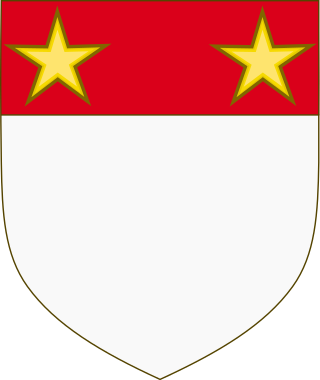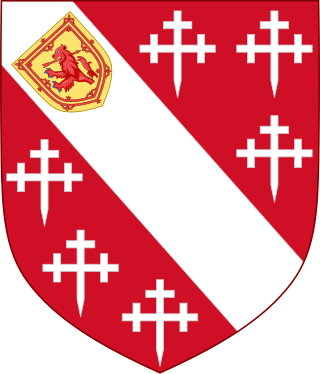This article includes a list of general references, but it lacks sufficient corresponding inline citations .(February 2013) |
| Earl of Effingham | |
|---|---|
 Arms: Gules, on a Bend, between six Crosses-Crosslet fitchée Argent, an Escutcheon in chief (of augmentation) Gules, charged with a Demi-Lion rampant, pierced through the mouth with an Arrow,within a Double-Tresure flory-counterflory Gules. Crest: On a Chapeau Gules, turned up Ermine, a Lion statant guardant, tail extended Or, ducally gorged Argent. Supporters: On either side a Lion Argent, charged on the shoulder with a Mullet for difference. Contents | |
| Creation date | 27 January 1837 |
| Created by | King William IV |
| Peerage | Peerage of the United Kingdom |
| First holder | Kenneth Howard, 1st Earl of Effingham |
| Present holder | Edward Howard, 8th Earl of Effingham |
| Heir apparent | Frederick Howard, Lord Howard of Effingham |
| Remainder to | the 1st Earl's heirs male of the body lawfully begotten |
| Subsidiary titles | Baron Howard of Effingham |
| Status | Extant |
| Motto | VIRTUS MILLE SCUTA (Virtue is worth a thousand shields) |

Earl of Effingham, in the County of Surrey, is a title in the Peerage of the United Kingdom, created in 1837 for Kenneth Howard, 11th Baron Howard of Effingham, named after the village of Effingham, Surrey, where heads of the family owned the manor.
This branch of the House of Howard stems from the naval commander and statesman Lord William Howard, senior son of Thomas Howard, 2nd Duke of Norfolk from his second marriage to Agnes Tylney. William served as Lord High Admiral of England, as Lord Chamberlain of the Household and as Lord Privy Seal. In 1554 he was created Baron Howard of Effingham in the Peerage of England after leading the defence of London against Wyatt's rebellion. His son and successor was better known to history as Charles Howard, 1st Earl of Nottingham, after being granted that title in 1596. He was Lord High Admiral from 1585 to 1618 and served as commander-in-chief of the English fleet against the Spanish Armada in 1588. In 1603 his eldest son and heir apparent William Howard (1577–1615), was summoned to the House of Lords through a writ of acceleration in his father's junior title of Baron Howard of Effingham. He predeceased his father.
The titles of the Earl of Nottingham passed to a younger son, the second Earl. He represented Bletchingley, Surrey and Sussex in the House of Commons and served as Lord-Lieutenant of Surrey. He was childless and was succeeded by his half-brother, the third Earl. On his death in 1681 the earldom became extinct.
The barony descended to the most senior male heir, who was a first cousin twice removed, who became the fifth Lord Howard. He was the great-grandson of Sir William Howard (d. 1600), a younger son of the first Baron: this Lord Howard of Effingham served as Governor of Virginia from 1683 to 1692.
His eldest son, the sixth Baron, died childless and was succeeded by his younger brother, the seventh Baron, a prominent military commander. In 1731 he was made Earl of Effingham in the Peerage of Great Britain. His grandson, the third Earl, served under William Pitt the Younger as Master of the Mint from 1784 to 1789 and was Governor of Jamaica from 1789 to 1791. He died childless and was succeeded by his younger brother, the fourth Earl. On his death in 1816 the earldom became extinct.
The barony descended to a third cousin, the eleventh Baron. He was the grandson of Lieutenant-General Thomas Howard, a son of George Howard, younger brother of the fifth Baron. Lord Howard of Effingham was a General in the Army. In 1837 the earldom of Effingham was revived when he was made Earl of Effingham, in the County of Surrey, in the Peerage of the United Kingdom. [1] He was succeeded by his eldest son, the second Earl. He represented Shaftesbury in Parliament as a Whig from 1841 to 1845. [2] The titles descended from father to son until the death of his grandson, the fourth Earl, in 1927. He never married and was succeeded by a first cousin, the fifth Earl, the son of Captain the Hon. Frederick Charles Howard (1840–1893), second son of the second Earl. His eldest son, the sixth Earl, died childless in 1996. He was succeeded by his nephew David, the seventh Earl, who died in 2022, being succeeded by his son, the 8th earl (born 1971), the present holder of the titles.
Another member of this branch of the Howard family was Field Marshal Sir George Howard active in the mid-18th century. He was the son of the aforementioned Lieutenant-General Thomas Howard and the brother of Henry Howard, father of Kenneth Alexander Howard, 1st Earl of Effingham.
The family seat in the 21st century is Readings Farmhouse, near Blackmore End, Essex.














